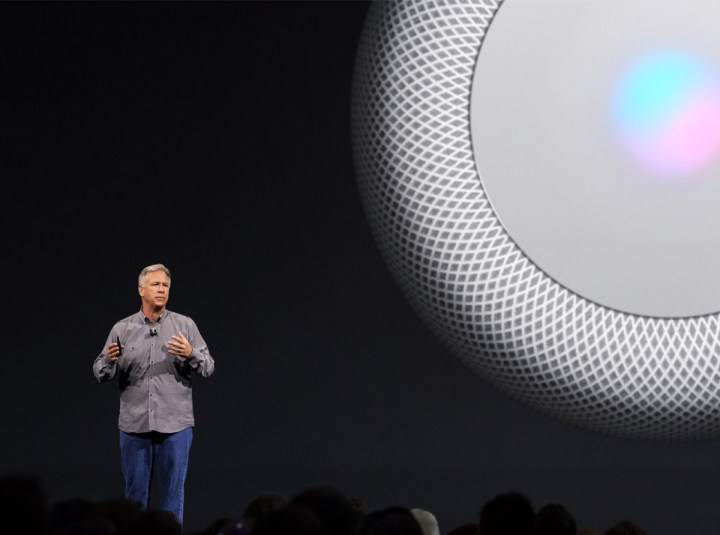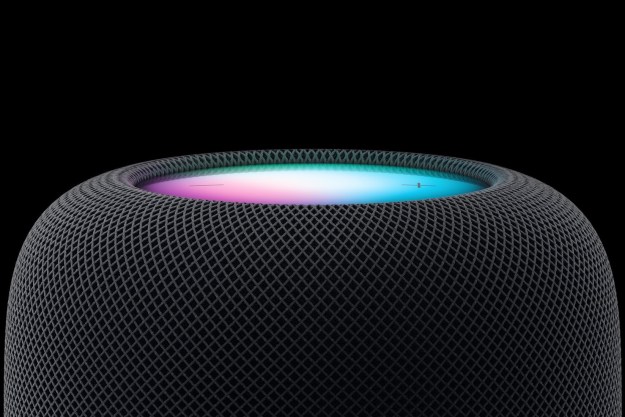
Apple’s tagline for the HomePod is that it offers “The chance to reinvent the way we enjoy music in the home,” but there’s an obvious problem with that claim: The way we enjoy music in the home has already been reinvented, and it wasn’t by Apple.
Apple’s audio products feel like cash grabs, not innovations.
The HomePod is a direct descendant of Amazon’s popular Echo smart speaker, and the Google Home. Its rounded design and omnidirectional driver configuration also borrow from hordes of other wireless speakers, from Sonos to Samsung. Even its “spatially aware” feature has been around in wireless speakers for years.
The HomePod is not an innovation. It’s a reluctant realization by Apple that, “yes, there’s a market for that,” and “yes, we should probably get in on it.” It’s the latest in a long line of signals that the maker of the iPod has other priorities now. It’s safe to say, Apple is no longer a music innovator.
The road to conformity
Like the HomePod, many of Apple’s latest audio products have been copycats. That’s not to say we don’t enjoy Apple’s contributions to the world of audio — it offers competitive, sleekly styled products, many of which garner positive reviews. But they feel like cash grabs, not innovations. Apple is more concerned with keeping up than standing out.
Apple’s most obvious copycat in recent years is its streaming service, Apple Music. Instead of building its own service, Apple reluctantly jumped into streaming after the writing was on the wall (and iTunes sales were plummeting). The service was a salvage job, mashing iTunes into Beats Music via Apple’s $3 billion Beats Electronics acquisition. It stands as a basic clone of Spotify, Deezer, and other on-demand services, right down to its price points, music resolution, and algorithm based music discovery tools. The bravest thing Apple did with Apple Music was to hire DJ Zane Lowe to run Beats 1, a 24-hour live radio service. Other than that, the only reason to use Apple Music instead of Spotify is a familiar one: You really like Apple.
If you thought Apple’s new AirPods were a revelation, we’re sorry to tell you that Apple was at least a year late to that party, too. Sure, the AirPods have a few intriguing features like the ability to automatically stream to one bud at a time, and they hold a connection better than a lot of the early competitors. But that’s no longer the case. From Bragi’s The Headphone to Jabra’s Elite Sport, there are plenty of better sounding alternatives to Apple’s AirPod available. In fact, the best thing the AirPods have going for them is, at $160, they still have a relatively low price point for their class — if you don’t mind the golf-tee look.
Of course we’ve seen this kind of cloning from multiple other companies — electronics companies (rightly) tend to jump on the trends. But this is Apple we’re talking about. It’s supposed to lead the way, not follow.
Mediocre components
It’s not just a lack of new product ideas that have hobbled Apple’s place in the audio world. Some of it is plain old cheaping out. In the years since Jobs and Co. created the iPod and the iPhone, Apple has seemed content to rest on its laurels as opposed to competing with other portable audio devices. Meanwhile, many of its competitors have forged ahead.
LG’s V20, the HTC 10, Sony’s Xperia phones, and many other phones pack impressive internal components like high-resolution digital-to-analog converters and quality headphone amplifiers for a premium sonic experience. The V20, for instance, packs a 75-stage analog volume control, as well as a Sabre ES9218 DAC from renowned premium chipmaker ESS Technology, whose chipsets also sit in premium audio devices like Astell & Kern’s astonishing portable players and Yamaha’s top-tier Aventage receivers. Xperia and HTC devices are also aimed at high-resolution playback. Sony relies on powerful components and software like the company’s Clear Audio+ technology, while the HTC 10 even boasts a built-in woofer and tweeter.
Apple has yet to partner with any high-end chipmakers like ESS (that we know of, anyway). Instead of working on sound performance, the company appears more interested in pushing thinner phones and proprietary technology like its Lightning digital connection. Which leads to my final point.
Pulling the plug(s)
Apple’s choice to dispense with the headphone jack may be the best argument that it still innovates — but in this case, it’s the kind of innovation many audio fans would just as soon go without. While it’s true that Lightning headphones can, in theory, offer a higher quality signal via 24-bit digital connection, there was simply no good reason to pull the jack at this point when it comes to sound quality and user convenience.
It’s easy to forget this is the house that Steve Jobs built.
Though the move has forced some third-party companies to push ahead with Lightning connections and personal DACs that outperform Apple’s included adapter, it has been a net negative for premium audio fans and audiophiles. Apple’s internal amplifier has never been accused of offering high-end sound, but with the jack gone, things are worse.
Audiophiles are now forced to make some serious concessions (and/or investments) to stick with Apple. Do we dump our best cans for a new, high-quality pair equipped with a Lightning connection, such as Audeze’s Sine or EL-8 Titanium? Do we look for a third-party Lightning DAC or wireless Bluetooth receiver to plug in our legacy cans? Or do we simply hold onto our iPhone 6 and 6S models, in the vain hope that Apple may reconsider its fervent quest for ever thinner devices? So far, we’ve chosen the latter.
It’s not just the iPhone, either. Home studio veterans and basic audio fans alike have watched as Apple has continued to remove peripherals, one port at a time, from its once-mighty MacBook. First it was the Firewire connection (both 400 and 800), which is still a mainstay in many legacy digital interfaces. Then went the HDMI. Then USB. At present, there’s nothing left on a MacBook to plug into save a few proprietary Thunderbolt ports and, thankfully, a headphone jack. How long before that gets the boot?
The road ahead
By now you may be saying, “So what? Why does it matter if Apple is pushing the envelope?” And we get that. After all, this is the multi-billion dollar company that shoehorned a U2 album into 100 million iPhones – not exactly the actions of a trendsetter. These days, it can be easy to forget this is the house that Steve Jobs built. The company that created the iPod and iTunes, whose very name is the same as the Beatles’ recording label, and whose desktop computers started a home-studio revolution back in the age of the floppy disk.
We still love our current Apple products, and though the HomePod’s $350 price point seems shockingly high, if the speaker does what Apple claims and “rocks the house” with zero distortion — and tacks on great functionality — we’ll gleefully give it a great score. But make no mistake; Apple no longer puts music and sound innovation first. It is a follower.
Let’s hope the company will break its streak soon and give music lovers something truly inspirational — iPhone 8, we’re looking at you, kid.
Editors' Recommendations
- AirPods 4: Everything we know about Apple’s next wireless earbuds
- SharePlay is coming to Apple TV and HomePod
- Apple has upgraded the AirPods Pro with lossless audio, sort of
- Apple Vision Pro brings TV, 3D movies to a massive, 100-foot-wide screen
- Soon, Apple AirPods Pro will be able to react to your environment



